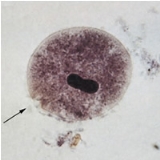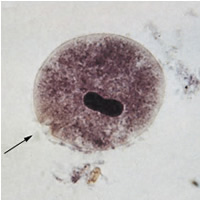
Balantidiasis
Encyclopedia
Balantidiasis is a protozoan infection
caused by infection with Balantidium coli
.
, metronidazole
, or diiodohydroxyquin.
Pigs are a major reservoir of the parasite, and infection of humans occurs more frequently in areas where pigs comingle with people. This includes places like the Philippines
, as previously mentioned, but also includes countries such as Bolivia
and Papua New Guinea
. But pigs are not the only animal where the parasite is found. In a Japanese study that analyzed the fecal samples in 56 mammalian species, Balantidium coli was found to be present not just in all the wild boars tested (with wild boars and pigs being considered the same species), it was also found in five species of non human primate: Chimpanzee (Pan troglodytes), White-handed gibbon (Hylobates lar), Squirrelmonkey (Saimiri sciurea), Sacred baboon (Comopithecus hamadryas), and Japanese macaque (Macaca fuscata). In other studies, Balantidium coli was also found in species from the orders Rodent
ia and Carnivora
.

s. In the trophozoite form, they can be oblong or spherical, and are typically 30 to 150 µm in length and 25 to 120 µm in width. It is its size at this stage that allows Balantidium coli to be characterized as the largest protozoan parasite of humans.
Trophozoites possess both a macronucleus and a micronucleus, and both are usually visible. The macronucleus is large and sausage-shaped while the micronucleus is less prominent. At this stage, the organism is not infective but it can replicate by transverse binary fission.
In its cyst stage, the parasite takes on a smaller, more spherical shape, with a diameter of around 40 to 60 µm. Unlike the trophozoite, whose surface is covered only with cilia, the cyst form has a tough wall made of one or more layers. The cyst form also differs from the trophozoite form because it is non-motile and does not undergo reproduction. Instead, the cyst is the form that the parasite takes when it causes infection.
Protozoan infection
Protozoan infections are parasitic diseases organisms formerly classified in the Kingdom Protozoa. They include organisms classified in Amoebozoa, Excavata, and Chromalveolata....
caused by infection with Balantidium coli
Balantidium coli
Balantidium coli is a parasitic species of ciliate protozoan that causes the disease Balantidiasis. It is the only member of the ciliate phylum known to be pathogenic to humans.-Morphology:...
.
Symptoms
Symptoms can be local due to involvement of the intestinal mucosa, or systemic in nature and include either diarrhea or constipation.Treatment
Balantidiasis can be treated with tetracycline, carbarsoneCarbarsone
Carbarsone is an arsenic-based antiprotozoal drug which has been used in the treatment of amebiasis and other infections. It was available for use in the United States as a drug for amebiasis as late as 1991. Thereafter, it remained available as an additive for turkey feed for improving weight...
, metronidazole
Metronidazole
Metronidazole is a nitroimidazole antibiotic medication used particularly for anaerobic bacteria and protozoa. Metronidazole is an antibiotic, amebicide, and antiprotozoal....
, or diiodohydroxyquin.
History and epidemiology
The first study to generate Balantidiasis in humans was undertaken by Cassagrandi and Barnagallo in 1896. However, this experiment was not successful in creating an infection and it was unclear whether Balantidium coli was the actual parasite used. The first case of Balantidiasis in the Philippines, where it is the most common, was reported in 1904. Currently, Balantidium coli is distributed worldwide but less than 1% of the human population is infected.Pigs are a major reservoir of the parasite, and infection of humans occurs more frequently in areas where pigs comingle with people. This includes places like the Philippines
Philippines
The Philippines , officially known as the Republic of the Philippines , is a country in Southeast Asia in the western Pacific Ocean. To its north across the Luzon Strait lies Taiwan. West across the South China Sea sits Vietnam...
, as previously mentioned, but also includes countries such as Bolivia
Bolivia
Bolivia officially known as Plurinational State of Bolivia , is a landlocked country in central South America. It is the poorest country in South America...
and Papua New Guinea
Papua New Guinea
Papua New Guinea , officially the Independent State of Papua New Guinea, is a country in Oceania, occupying the eastern half of the island of New Guinea and numerous offshore islands...
. But pigs are not the only animal where the parasite is found. In a Japanese study that analyzed the fecal samples in 56 mammalian species, Balantidium coli was found to be present not just in all the wild boars tested (with wild boars and pigs being considered the same species), it was also found in five species of non human primate: Chimpanzee (Pan troglodytes), White-handed gibbon (Hylobates lar), Squirrelmonkey (Saimiri sciurea), Sacred baboon (Comopithecus hamadryas), and Japanese macaque (Macaca fuscata). In other studies, Balantidium coli was also found in species from the orders Rodent
Rodent
Rodentia is an order of mammals also known as rodents, characterised by two continuously growing incisors in the upper and lower jaws which must be kept short by gnawing....
ia and Carnivora
Carnivora
The diverse order Carnivora |Latin]] carō "flesh", + vorāre "to devour") includes over 260 species of placental mammals. Its members are formally referred to as carnivorans, while the word "carnivore" can refer to any meat-eating animal...
.

Morphology
Balantidium coli exists in either of two developmental stages: Trophozoites and CystMicrobial cyst
A microbial cyst is a resting or dormant stage of a microorganism, usually a bacterium or a protist, that helps the organism to survive in unfavorable environmental conditions. It can be thought of as a state of suspended animation in which the metabolic processes of the cell are slowed down and...
s. In the trophozoite form, they can be oblong or spherical, and are typically 30 to 150 µm in length and 25 to 120 µm in width. It is its size at this stage that allows Balantidium coli to be characterized as the largest protozoan parasite of humans.
Trophozoites possess both a macronucleus and a micronucleus, and both are usually visible. The macronucleus is large and sausage-shaped while the micronucleus is less prominent. At this stage, the organism is not infective but it can replicate by transverse binary fission.
In its cyst stage, the parasite takes on a smaller, more spherical shape, with a diameter of around 40 to 60 µm. Unlike the trophozoite, whose surface is covered only with cilia, the cyst form has a tough wall made of one or more layers. The cyst form also differs from the trophozoite form because it is non-motile and does not undergo reproduction. Instead, the cyst is the form that the parasite takes when it causes infection.
Disease diagnosis
The diagnosis of Balantidiasis can be an intricate process, partly because the related symptoms may or may not be present. However, the diagnosis of Balantidiasis can be considered when a patient has diarrhea combined with a probable history of current exposure to amebiasis through travel, contact with infected persons, or anal intercourse. In addition, the diagnosis of Balantidiasis can be made by microscopic examination of stool or tissue samples.Prevention
Preventative measures require effective personal and community hygiene. Some specific safeguards include the following:- Purification of drinking water.
- Proper handling of food.
- Careful disposal of human feces.
- Monitoring the contacts of balantidiasis patients.

